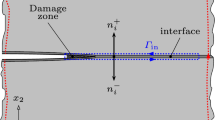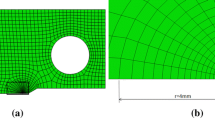Abstract
The energetics controlling delamination versus echelon crack advance in a tape composite laminate subjected to anti-plane shear loading are studied. The finite element method is used to model both single and multiple echelon cracks that intersect the planar delamination front. Energy release rates are determined along the echelon crack peripheries and along the planar delamination front. Various echelon crack shapes are evaluated in order to represent progressive stages of growth. It is shown that the echelon cracks advance due to primarily mode I conditions, whereas a mode III criterion is appropriate for predicting advance of the planar delamination. It is further shown that mode I advance of the echelon crack and mode III advance of the delamination are competing yet coupled processes, and that the sequence of events predicted by this approach agrees with what has been observed experimentally.

















Similar content being viewed by others
References
Andersons J, König M (2004) Dependence of fracture toughness of composite laminates on interface ply orientations and delamination growth direction. Compos Sci Technol 64(13–14):2139–2152
Czabaj MW, Ratcliffe JG (2013) Comparison of intralaminar and interlaminar mode I fracture toughnesses of a unidirectional IM7/8552 carbon/epoxy composite. Compos Sci Technol 89:15–23
Czabaj MW, Ratcliffe JG, Davidson BD (2014) Observation of intralaminar cracking in the edge crack torsion specimens. Eng Fract Mech 120(4):1–14
Czabaj MW, Ratcliffe JG, Davidson BD (2016) A modified edge crack torsion test for measurement of mode III fracture toughness of laminated tape composites. In: Davidson BD, Ratcliffe JG, Czabaj MW (eds) Proceedings of 31st American Society Composite Technical Conference DEStech Pub, Pennsylvania, USA
Davidson BD, Sediles FO (2011) Mixed mode I–II–III delamination toughness determination via a shear–torsion–bending test. Compos Part A 42(6):589–603
Goldstein RV, Osipenko NM (2012) Successive development of the structure of a fracture near the front of a longitudinal shear crack. Doklady Phys 57(7):164–167
Horner AL (2016) Crack growth mechanisms under anti-plane shear in composite laminates. Dissertation, Syracuse University
Horner AL, Czabaj MW, Davidson BD, Ratcliffe JG (2015) Three-dimensional crack surface evolution in mode III delamination toughness tests. Eng Fract Mech 149(11):313–25
Horner AL, Davidson BD (2015) Fracture surface evolution and apparent delamination toughness in split composite beam specimens subjected to mixed mode I–III loading. Compos Part A 79:92–102
Johnston AL, Davidson BD, Simon KK (2014) Assessment of split-beam-type tests for mode III delamination toughness determination. Int J Fract 185(1–2):31–48
Johnston AL, Davidson BD (2014) Intrinsic coupling of near-tip matrix crack formation to mode III delamination advance in laminated polymeric matrix composites. Int J Solids Struct 51(13):2360–2369
Kassir MK, Sih GC (1975) Three dimensional crack problems. In: Sih GC (ed) Mechanics of fracture, vol 2. Noordhoff International Publishing, Leyden
Knauss WG (1970) An observation of crack propagation in anti-plane shear. Int J Fract Mech 6(2):183–187
Kotousov A, Berto F, Lazzarin P, Pegorin F (2012) Three dimensional finite element mixed fracture mode under anti-plane loading of a crack. Theor Appl Fract Mech 62(12):26–33
Krueger R (2004) The virtual crack closure technique: history, approach and application. Appl Mech Rev 57:109–143
Newman JC Jr, Raju IS (1983) Stress-intensity factor equations for cracks in three-dimensional finite bodies. In: Lewis JC, Sines G (eds) Fracture mechanics: fourteenth symposium—volume I: theory and analysis, ASTM STP 791 American Society for Testing and Materials, pp I-238–I-265
O’Brien TK, Johnston WM, Toland GJ (2010) Mode II interlaminar fracture toughness and fatigue characterization of a graphite epoxy composite material, NASA-TM-2010-216838
O’Brien TK, Krueger R (2003) Analysis of flexural tests for transverse tensile strength characterization of unidirectional composites. J Compos Technol Res 25:1–19
Pham KH, Ravi-Chandar K (2014) Further examination of the criterion for crack initiation under mixed-mode I+III loading. Int J Fract 189:121–138
Pham KH, Ravi-Chandar K (2016) On the growth of cracks under mixed-mode I+III loading. Int J Fract 199:105–134
Pham KH, Ravi-Chandar K (2017) The formation and growth of echelon cracks in brittle materials. Int J Fract. doi:10.1007/s10704-017-0212-4
Pons AJ, Karma A (2010) Helical crack-front instability in mixed-mode fracture. Nature 464:85–89
Ressel M, Theilig H (2012) Finite element analysis of secondary cracks at a crack front under pure mode III loading. Key Eng Mater 488–489:605–608
Rybicki EF, Kanninen MF (1977) A finite element calculation of stress intensity factors by a modified crack closure integral. Eng Fract Mech 9:931–938
Smith SA, Raju IS (1999) Evaluation of stress-intensity factors using general finite-element models. In: Panontin TL, Sheppard SD (eds) Fatigue and fracture mechanics, vol 29. ASTM STP 1321 American Society for Testing and Materials, Philadelphia, pp 176–200
Acknowledgements
This work was partially supported by a National Science Foundation Graduate Research Fellowship under Grant No. DGE-1247399.
Author information
Authors and Affiliations
Corresponding author
Rights and permissions
About this article
Cite this article
Horner, A.L., Davidson, B.D. Energy release rate prediction for delamination versus echelon crack advance under global mode III loadings. Int J Fract 207, 161–179 (2017). https://doi.org/10.1007/s10704-017-0226-y
Received:
Accepted:
Published:
Issue Date:
DOI: https://doi.org/10.1007/s10704-017-0226-y




